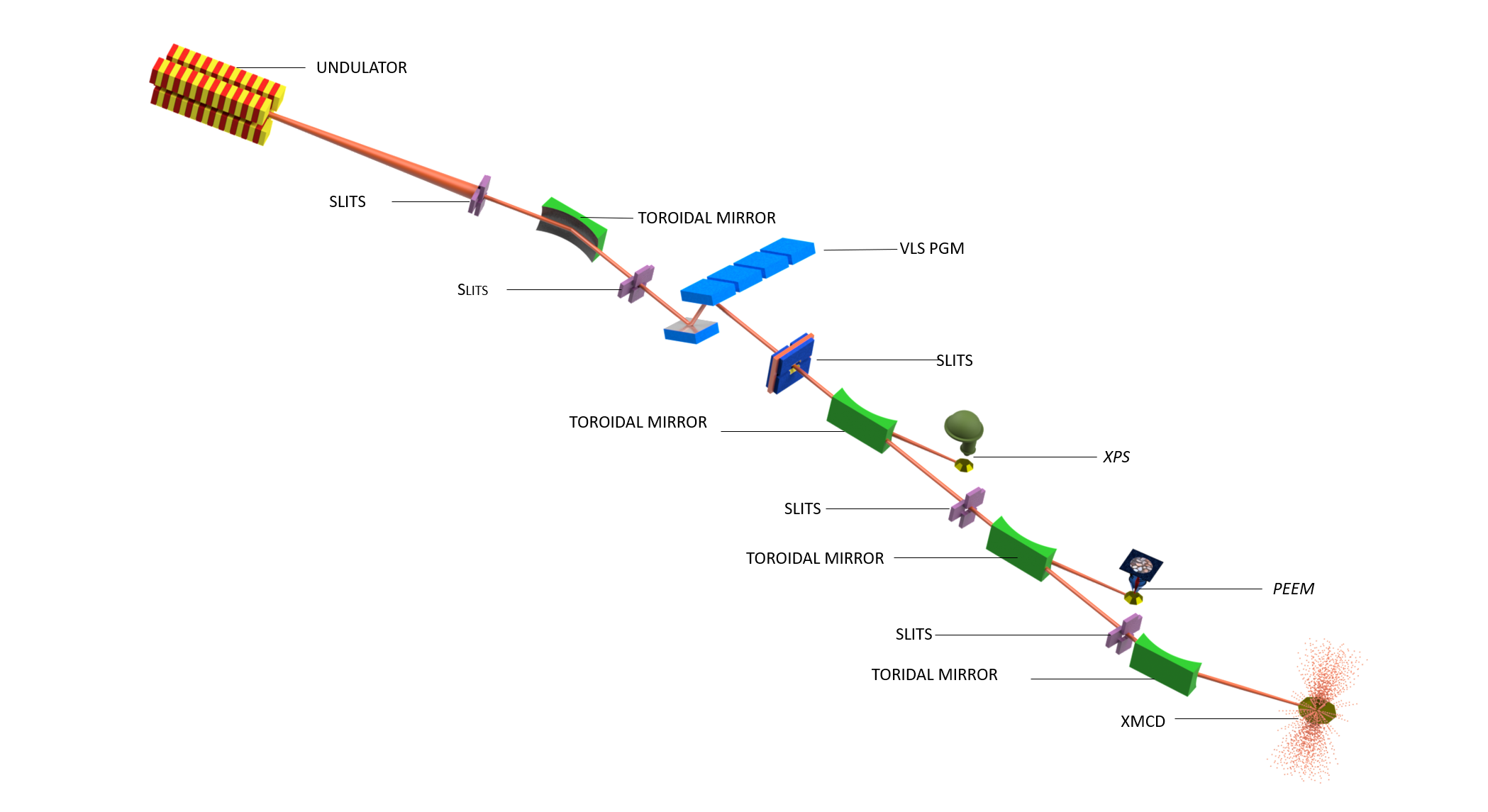CONTACT & STAFF
Facility E-mail: sabia@lnls.br
Coordination: Julio C. Cezar
Tel.: +55 19 3512 1292
E-mail: julio.cezar@lnls.br
Click here for more information on this Facility team.
The SABIÁ (Soft X-ray ABsorption spectroscopy and ImAging) beam line operates in the soft X-rays region using undulators to provide polarization control and plane gratings for monochromatization. The main techniques available are X-rays absorption spectroscopy (XAS) and photoemission electron microscopy (PEEM). Several flavours of XAS are available and allow the users to investigate the structural and magnetic properties of matter with chemical selectivity. The soft X-ray range covered at SABIA includes absorption L edges for all 3d transition metals, the K edges of light elements like carbon, nitrogen and oxygen, and the M4, M5 edges of rare earths. Using PEEM, the same absorption techniques can be used with spatial resolution of the order of few tens of nanometers.
The SABIÁ beamline will work in close collaboration with the In-situ Growth Laboratory (LCIS), were the users have a very versatile system for the fabrication and pre-characterization of thin films and heterostructures. These saples can be trasfered to the SABIA beam line under ultra high vacuum condition.
Facility E-mail: sabia@lnls.br
Coordination: Julio C. Cezar
Tel.: +55 19 3512 1292
E-mail: julio.cezar@lnls.br
Click here for more information on this Facility team.
Variations in the crystalline structure of the materials make the X-ray absorption dependent on the orientation between the electric field of the X-ray beam and the crystalline axes of the sample. This effect is known as natural linear dichroism (XLD, X-ray linear dichroism) and is a powerful source of information about variations in the structure of interfaces and surfaces of thin and multilayer films. In addition, the absorption of linearly polarized radiation may vary with the magnetization of the sample. In this case, we are dealing with magnetic linear dichroism (XLMD, X-ray linear magnetic dichroism) and we have magnetic information with chemical sensitivity.
Materials that have a non-zero magnetic moment absorb differently the two possible circularly polarized X-ray helicities (left and right circular polarizations). This difference is called circular dichroism, and when carried out at the absorption edge, it allows to obtain the magnetic contributions of each chemical element independently. In addition, in many cases it is possible to determine the spin and orbital components of magnetism. The sign of dichroism in general is maximum at the peak of the edge and absorption of each element. Keeping the energy fixed at that point in the spectrum and varying the applied magnetic field, it is possible to obtain magnetic hysteresis curves for each element in the sample. This aspect is particularly important in the characterization of new permanent magnets.
The matter when interacting with the X-ray beam emits electrons. This effect is particularly important in the soft X-ray region. Using a column similar to that of a transmission electron microscope, it is possible to obtain images based on the electrons emitted in the absorption process. This is the basic principle of PEEM (photoemission electron microscopy), which allows users to obtain spectroscopic information with spatial resolution of up to a few tens of nanometers to be obtained. In addition, the XMLD and XMCD methods remain valid, and using the X-ray beam polarization appropriately, it is possible to obtain magnetic information with such spatial resolution. This possibility is particularly interesting in the study of magnetic domain walls and their dynamics. Furthermore, given the chemical sensitivity inherent to the absorption of X-rays, the technique has great potential in geosciences, environmental studies, among others, where it is important to locate the spatial concentration of the various chemical elements in the sample.

| Element | Type | Position (m) | Description |
|---|---|---|---|
| SOURCE | Insertion Device | 0.0 | Delta undulator with full polarization control |
| M1 | Toroidal Mirror | 31.3 | Thermal load absorber |
| M2 | Plane Mirror | 28.0 | First monochromator optics |
| G1 (M3) | Diffraction Grating | 31.5 | Main element of the monochromator |
| ES | Exit Slit | 39.5 | End element of the monochromatization |
| M4 | Toroidal Mirror | 43.8 | Focus at the arm A (superconducting magnet) |
| HFM | Experimental Station | 55.3 | Superconducting Magnet |
| M5 | Toroidal Mirror | 78.5 | Focus at the arm B (PEEM) |
| M6 | Toroidal Mirror | 78.5 | Focus at the arm C (available) |
| PEEM | Experimental Station | 82.8 | Photoemission electron microscopy |
| Arm C | Experimental Station | 90.0 | Port available for future experiments |
| Parameter | Value | Condition |
|---|---|---|
| Energy range | 100 – 2000 eV | |
| Energy resolution (ΔE/E) | ~5×10-4 | |
| Energy scan | Yes | |
| Beam size | 20 x 80 μm2 | Magnet |
| Beam size | Variable, up to 4 x 12 μm2 | PEEM |
| Beam size | ~10 x 30 μm2 |